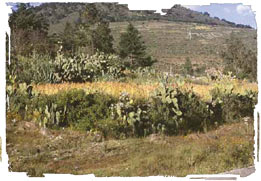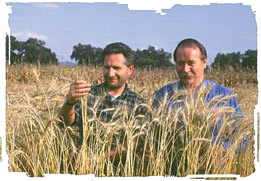CIMMYT E-News, vol 2 no. 10, October 2005
 In Mexico, the wheat of the conquistadors helps scientists in their battle against drought.
In Mexico, the wheat of the conquistadors helps scientists in their battle against drought.
Wheat first came to the Western hemisphere with the arrival of the Spanish conquistadors about 500 years ago. Since then, generations of Mexican farmers have tended their wheat fields with traditional varieties that differ little from their forebears by virtue of wheat’s self-pollinating nature. Today, these time-tested wheats represent a new source of genetic diversity that could improve yields in drought-ridden areas by as much as 30 percent.
CIMMYT scientists and their Mexican collaborators have gathered thousands of traditional wheat varieties, called landraces, from diverse locations in Mexico. Farmer and natural selection over five centuries have combined to screen these wheats for drought tolerance under often severe conditions. Researchers are looking to capture the drought adaptive traits of these hearty old-timers and breed them into modern, higher yielding varieties. Of the original 2,100 varietal samples collected, nine are very promising.
“What we found was that the best of these landraces show considerably higher expression for certain drought and heat adaptive traits than common wheat,” says CIMMYT wheat physiologist Matthew Reynolds. “Heat and drought stress often go hand in hand. Hot conditions exacerbate drought by evaporating more moisture from the soil, and when plants are dry their temperature rises. But with these traits, we might be able to increase the potential for yield under drought.” Drought plagues more than half of the wheat area in the developing world and so is a high priority for CIMMYT’s Rainfed Wheat Program.

There is a range of traits that can help wheat plants cope with dry conditions. Early in the season, many of the landraces showed an increased ability to accumulate carbohydrates in their stem, reserves that can be used later when the season gets drier for grain growth or to send roots deeper into the soil in search of water. A vigorous and rapidly growing leaf canopy can shade surrounding soil from the sun’s drying rays, thereby conserving soil moisture. Under stress conditions, the wheat spike can contribute to photosynthesis, which in turn promotes better development of the grain. While all of wheat’s organs can play an important role in producing grain in the face of drought, the root system is probably the most vital.
At a depth of 60-90cm below the soil, landraces had a more extensive root system and thus were able to extract more water out of the soil than common wheat. Not only did the landraces find more water, but they also used it more efficiently. “We found an association in these landraces between increased yield and root length density,” Reynolds says. Where there is a more extensive root system, the wheat is able to draw more water and nutrients out of the soil, increasing grain. Tallied up, the potential yield gain from these landraces may be considerable for farmers in dry areas.
“The next step is introducing these traits into the CIMMYT wheat breeding program,” says Reynolds. “Breeding and physiology work very closely to translate new information like this into useful products as quickly as possible by combining new drought adaptive traits with other traits such as disease resistance, good height, and time to maturity.”
For further information, contact Matthew Reynolds (m.reynolds@cgiar.org).
 Nutrition, health and food security
Nutrition, health and food security